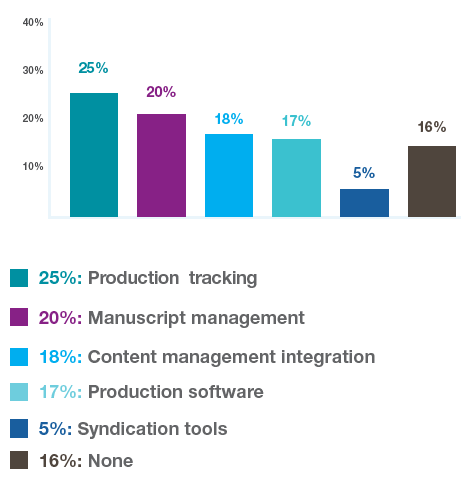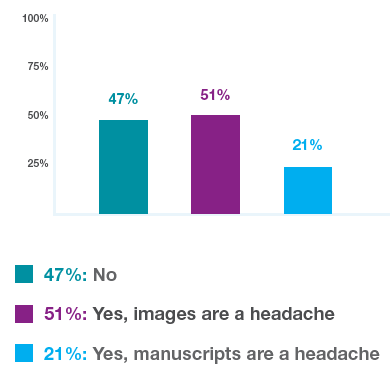In a recent survey, almost 50% of publishers said they have issues with manuscript submission; leaving the other 50% who have no issue at all.
We found this a little odd because manuscript submission is a big headache for many of our clients, especially the graphics and images that accompany a manuscript. So much so that we built a software solution to help fix it.
So where is the disconnect? Why is half the world just fine with their process for acquiring author manuscripts, and the other half frustrated with it?
We took a closer look at the data to determine what factors are affecting publisher success in acquiring author manuscripts.
Do you have issues acquiring manuscripts and graphics
according to your outlined manuscript submission process?
Type of publisher
Our first thought was to look at how different types of publishers responded.
69% of scholarly journals do not have manuscript submission issues, whereas scholarly books, education/textbooks, trade, professional, and university presses were are all little more dissatisfied, with 50-56% experiencing issues.
Use of formal manuscript submission software
Scholarly journals (the group with the least issue) had the highest instance of a formal manuscript submission system at 75%. The other groups were, again, around the 55% mark. It makes perfect sense that a formal system would make the submission process smoother.
Ease of manuscript submission guidelines
We did not specifically ask publishers how complicated or easy their submission requirements were. However, publishing consultant Bill Kasdorf suspects that only 53% of respondents reporting having issues with author compliance may be artificially low.
In an effort to keep their authors happy, he said, “a lot of publishers have really minimal requirements for authors, which means it is easy for authors to comply.”
Easy for authors, tough on production
While easy submission guidelines may keep authors happy, it’s a big source of frustration–entailing costs and delays–for production offices.
The production manager from a large publisher we interviewed shared, “They [acquisitions] would just take whatever the author provided — 72 dpi screen grabs, or things created in Microsoft Paint — and say, ‘Oh yeah, we’ll take that,’ and then pass it to production. And then we have to go back to the author and get it fixed, or just publish it that way.”
Stories like this were the basis for our PACE software, a simple way for authors to prep their images and graphics (including PPT) before submitting a manuscript to the publisher.
Getting the first step right
With improving first-proof acceptance an important goal for many of the publishers surveyed, it wasn’t surprising that manuscript management was the second highest area publishers were looking to automate in the next 6-18 months.
What automation advancements are you looking
to implement over the next 6-18 months?

Receiving a manuscript and all its accompanying components correctly upfront is a big time saver in the production process. As publishers look to create born-accessible content, we foresee acquiring detailed image descriptions from authors will become another piece of the manuscript submission puzzle.
Are you one of the frustrated publishers? We’ve helped publishers realize an 85% increase in first proof acceptance rates and can help you, too. Contact us to start a conversation.

